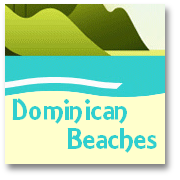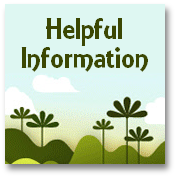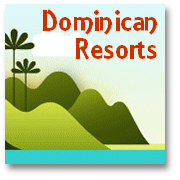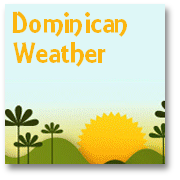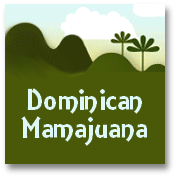Dominican Republic Information:
So What Would You Like To Know About The Dominican Republic?
This page aims to provide all the general Dominican Republic information you might like to know...and a bit more besides. If we have not included what you would like to know, then please check out our other pages. If you are still unsatisfied drop us a line through our 'contact us' page and we'll get back to you with an answer as soon as we can!
Dominican Republic Information:
Geography
Where Is It?
Of course, you didn't sleep in geography classes; it's just a lapse of memory if you don't recall it ;-) but just in case: The Dominican Republic is one of the Caribbean nations, or the West Indies as some prefer to say, it is also one of the Greater Antilles group of Islands.
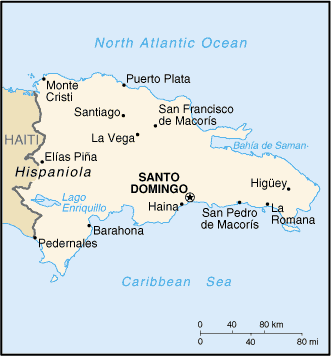
Dominican Republic information page -Dominican Republic map (1)
The island of Hispaniola, hosting Haiti on the western third and the Dominican Republic on the eastern two-thirds, is situated between Cuba and Jamaica to the west and the Virgin Islands of the USA to the east.
South of Hispaniola is the Caribbean Sea; to the north is the Atlantic Ocean. We would like to tell you how far it is from the Pirates of the Caribbean, but they didn't e-mail us their location in time before this page was written, so we hope you'll have the patience to come back in a few weeks time to see if we've heard from them.
I heard about somewhere called Dominica. Is this the same place?
No. Dominica is an independent country on an island in the Lesser Antilles.
There is no connection, except that Christopher Columbus visited Dominica in 1493; the year after he found the Dominican Republic. Apparently, his tour guide forgot where he was and mixed up the names ;-)
Dominican Republic information: Geographic coordinates:
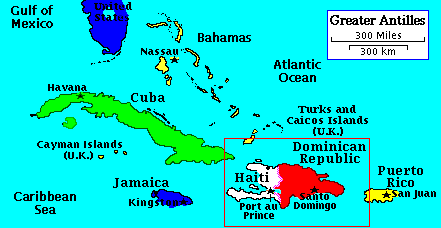
Dominican Republic information page -Dominican Republic map (2)
Latitude: 19° 00' N. Longitude: 70° 40' W.
Map references:
Central America and the Caribbean (West Indies/Greater Antilles).
How Big Is The Dominican Republic?
It's often said that size doesn't matter, but for those who must know, it's slightly larger than twice the size of New Hampshire. Exciting, isn't it?
The Dominican Republic, the second largest island in the Caribbean, occupies the eastern two thirds of the island of Hispaniola, which lies in the Caribbean sea between Cuba and Puerto Rico. It covers almost 19,000 square miles, with fertile plains in the north, and dry and almost desert areas to the south-west of the island. Three mountain ranges run from east to west of the country.
In the central mountain range (Cordillera Central) is Pico Duarte, the highest mountain in the Caribbean at 3,112 meters.
But to be more specific:
Total area: 18,815 square miles (48,730 km²).
Land area: 18,680 square miles (48,380 km²).
Water surface: 135 square miles (350 km²).
How About Its Neighbors?
Land boundaries: 224 miles (360 km) border with Haiti. For more information about the history of the Dominican Republic and Haiti,
click here.
And The Sea?
Coastline: 800 miles (1,288 km).
Maritime claims: Contiguous zone: 24 nautical miles (NM).
Territorial sea: 6 NM.
Continental shelf: 200 NM or to the edge of the continental margin exclusive.
Economic zone: 200 NM.
How's The Weather?
Climate: Tropical maritime, with temperatures averaging between 18 degrees Centigrade (64.4 degrees Fahrenheit) in December and 37 degrees Centigrade (98.6 degrees Fahrenheit) in July. Humidity is high, especially in coastal areas. The wetter months are May, June, August, September and November.
Find more details and check out what the Dominican Republic weather is like TODAY on our
weather page
Dominican Republic information: What Does The Place Look Like?
Terrain: Rugged highlands and mountains with fertile valleys interspersed. A very green country.
Lowest point: Lago Enriquillo 151 ft (46 meters) below the sea.
Highest point: Pico Duarte 10,416 ft (3,175 meters).
Anything Else From Geography Classes To Refresh?
Well, yes! There's quite a lot more Dominican Republic information! Here's a brief summary of just some of the facts, figures and statistics relating to our homeland:
Natural resources: Nickel, bauxite, gold, silver.
Land use: Arable land: 21.08%
Permanent crops: 9.92%
Other: 69% (1998 estimate).
Irrigated land: 1,008 square miles (2,590 sq km) (1998 estimate).
Natural hazards: The Dominican Republic is in the middle of the hurricane belt and may endure severe storms from June to October; occasional flooding; periodic droughts. Nothing to worry about.
Environment - current issues: Soil eroding into the sea damages coral reefs; deforestation.
Environment - international agreements: Party to: Biodiversity, Climate Change, Desertification, Endangered Species, Hazardous Wastes, Marine Dumping, Marine Life Conservation, Nuclear Test Ban, Ozone Layer Protection, Ship Pollution signed, but not ratified: Law of the Sea.
What Sort Of Folks Are Living There?
Population: 8,715,602 (July 2003 estimate).
How old are they?
Percentage of population:
Age, years
Guys, number Ladies, number
0-14
33.6%
1,497,777
1,431,104
15-64
61.2%
2,719,505
2,614,495
65 and over
5.2%
212,045
240,676
Median age:
Total: 23.5 years.
Male: 23.3 years.
Female: 23.7 years.
Data from: 2002.
Population growth rate: 1.36% per year (2003 est.).
Birth rate: 23.94 births/1,000 population (2003 est.).
Death rate: 6.88 deaths/1,000 population (2003 est.)
Net migration rate: Emigration of 3.43 persons/1,000 population (2003 est.).
Sex ratio: At birth: 1.05 male(s)/female
Under 15 years: 1.05 male(s)/female
15-64 years: 1.04 male(s)/female
65 years and over: 0.88 male(s)/female
Total population: 1.03 male(s)/female (2003 est.)
No other sex information available.
Infant mortality rate:
Total: 34.19 deaths/1,000 live births
Female: 31.55 deaths/1,000 live births
Male: 36.7 deaths/1,000 live births. (2003 est.)
Life expectancy at birth
Total population: 67.96 years
Male: 66.41 years
Female: 69.58 years(2003 est.)
Total fertility rate: 2.92 children born/woman (2003 est.)
Nationality: Dominican.
Ethnic groups: White 16%, Black 11%, mixed 73%.
Religion: Roman Catholic 95%.
Language: Spanish.
Literacy: Definition: Age 15 and over can read and write.
Total population: 84.7%.
Male: 84.6%. Female:84.8%. (2003 est.)
Official Stuff
Country name: Dominican Republic; República Dominicana in Spanish, the local language.
Government type: Representative democracy.
Capital: Santo Domingo.
Administrative divisions: 29 provinces (provincias) and 1 district (distrito):
1. Azua
2. Baoruco
3. Barahona
4. Dajabón
5. Distrito Nacional (you guessed it; this one is the district)
6. Duarte
7. Elías Piña
8. El Seibo
9. Espaillat
10. Hato Mayor
11. Independencia
12. La Altagracia
13. La Romana
14. La Vega
15. María Trinidad Sánchez
16. Monseñor Nouel
17. Monte Cristi
18. Monte Plata
19. Pedernales
20. Peravia
21. Puerto Plata
22. Salcedo
23. Samaná
24. Sánchez Ramírez
25. San Cristóbal
26. San Juan
27. San Pedro de Macorís
28. Santiago
29. Santiago Rodríguez
30. Valverde
Government & Independence
Independence: 27 February 1844 (from Haiti).
National holiday: Independence Day, 27 February (1844).
Constitution: 28 November 1966.
Legal system: Based on French civil codes.
Suffrage: 18 years of age, universal and compulsory; married persons regardless of age. Members of the armed forces and police cannot vote.
Executive branch (16 August 2000 - August 2004):
Chief of state & head of government: President: Leonel Fernández Reyna (Doctor)
Vice President: Rafael Alburqueque
Cabinet: Cabinet nominated by the president.
Elections: President and vice president elected on the same ticket by popular vote for four-year terms; election last held May 2004.
Legislative branch: Bicameral National Congress (Congreso Nacional) consists of the Senate (Senado) with 30 seats; members are elected by popular vote to serve four-year terms) and the Chamber of Deputies (Camara de Diputados) with 149 seats; members are elected by popular vote to serve four-year terms.
Last elections for both were held on 16 May 2004.
To return to the TOP of the page click:
Dominican Republic information
Dominican Republic information:
The Dominican Republic Flag
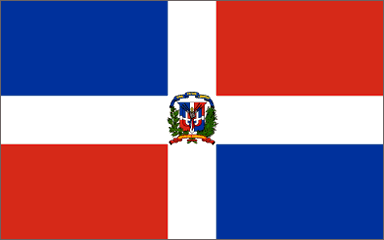
A centered white cross that extends to the edges divides the flag into four rectangles - the top ones are blue (hoist side) and red, and the bottom ones are red (hoist side) and blue.
A small coat of arms featuring a shield supported by an olive branch (left) and a palm branch (right) is at the center of the cross; above the shield a blue ribbon displays the motto:
DIOS, PATRIA, LIBERTAD (God, Fatherland, Liberty)
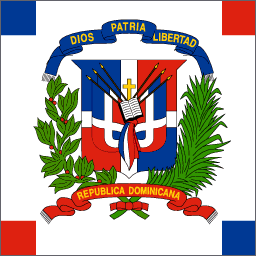
and below the shield, REPUBLICA DOMINICANA appears on a red ribbon.
Dominican Republic Information: A Brief Economic Overview:
The Dominican Republic's economy experienced dramatic growth over the last decade, even though the economy was hit hard by Hurricane Georges in 1998.
Although the country has long been viewed primarily as an exporter of sugar, coffee, and tobacco, in recent years the service sector has overtaken agriculture as the economy's largest employer, due to growth in tourism and free trade zones.
The country suffers from marked income inequality; the poorest half of the population receives less than one-fifth of GNP, while the richest 10% enjoy nearly 40% of national income. Growth probably will slow in 2003 with reduced tourism and expected low growth in the US economy, the source of 87% of export revenues.
GDP: Purchasing power parity - $53.78 billion (2002 est.)
GDP - real growth rate: 4.1% (2002 est.)
GDP - per capita: Purchasing power parity - $6,300 (2002 est.)
GDP - composition by sector: Agriculture: 11% Industry: 34% Services: 55% (2001)
Population below poverty line: 25%
Household income or consumption by Percentage share:
Lowest 10%: 2.1%
Highest 10%: 37.9% (1998)
Distribution of family income - Gini index: 47.4 (1998)
Inflation rate (consumer prices): 5.3% (2002 est.)
Labor force: 2.3 million - 2.6 million
Labor force - by occupation: Services and government 58.7%, industry 24.3%, agriculture 17% (1998 est.)
Unemployment rate: 14.5% (2002 est.)
Budget: Revenues: $2.9 billion Expenditures: $3.2 billion, including capital expenditures of $1.1 billion (2001 est.)
Dominican Republic information: Key Industries in the Dominican Republic:
1)Tourism
2)Sugar processing
3)Ferronickel and gold mining
4)Textiles
5)Cement
6)Tobacco
Industrial production growth rate: 2% (2001 est.)
Electricity - production:
9.186 billion kWh (2001)
Electricity - production by source: Fossil fuel: 92% Hydro: 7.6% Other: 0.4% (2001) Nuclear: 0%
Electricity - consumption: 8.543 billion kWh (2001)
Oil - consumption: 129,000 bbl/day (2001 est.)
Dominican Republic information: Agriculture - products:
1)Sugarcane
2)Coffee
3)Cotton
4)Cocoa
5)Tobacco
6)Rice
7)Beans
8)Potatoes
9)Corn
10)Bananas
11)Cattle
12)Pigs
13)Dairy products
14)Beef
15)Eggs
Dominican Republic information: Dominican Republic Major Exports:
$5.3 billion f.o.b. (2002 est.)
Exports - commodities:
1)Ferronickel
2)Sugar
3)Gold
4)Silver
5)Coffee
6)Cocoa
7)Tobacco
8)Meats
9)Consumer goods
Exports - partners: US 85%, Canada 1.6%, UK 1.6% (2002)
Dominican Republic information: Dominican Republic Major Imports:
$8.7 billion f.o.b. (2002 est.)
Imports - commodities:
1)Foodstuffs
2)Petroleum
3)Cotton
4)And fabrics, chemicals and pharmaceuticals
Imports - partners: US 51.5%, Venezuela 9.6%, Mexico 5.1%, Spain 4% (2002)
Debt - external: $4.8 billion (2002 est.)
Economic aid - recipient: $239.6 million (1995)
Currency: Dominican peso (DOP)
Currency code: DOP.
Exchange rates:
Dominican pesos per US dollar - 18.61 (2002), 16.95 (2001), 16.42 (2000), 16.03 (1999), 15.27 (1998)
Fiscal year: Calendar year
Dominican Republic information: Communications
Telephones - main lines in use: 709,000 (1997)
Telephones - mobile cellular: 130,149 (1997)
Dominican Republic information: Telephone system overview:
General assessment: NA
Domestic: Relatively efficient system based on islandwide microwave radio relay network.
International: 1 coaxial submarine cable; satellite earth station - 1 Intelsat (Atlantic Ocean)
Radio broadcast stations: AM 120, FM 56, shortwave 4 (1998)
Television broadcast stations: 25 (1997)
Internet country code:
.do
Internet Service Providers (ISPs): 24 (2000)
Internet users: 186,000 (2002)
Dominican Republic information: Transportation
Railways: Total: 1,503 km
Standard gauge: 375 km 1.435-m gauge note:
986 km also operated by sugar companies in 1.076-m, 0.889-m, and 0.762-m gauges (2002)
Narrow gauge: 142 km 0.762-m gauge
Highways: Total: 12,600 km
Paved: 6,224 km
Unpaved: 6,376 km (1999)
Waterways: None
Pipelines: Crude oil 96 km; petroleum products 8 km
Ports and harbors:
1)Barahona
2)La Romana
3)Manzanillo
4)Puerto Plata
5)San Pedro de Macoris
6)Santo Domingo
Merchant marine: Total: 1 ships (1,000 GRT or over) 1,587 GRT/1,165 DWT ships by type: cargo 1 (2002 est.)
Dominican Republic information: Dominican Republic Airports:
30 (2002)
Airports - with paved runways:
Total: 13 Over 3,047 m: 3 2,438 to 3,047 m: 3 1,524 to 2,437 m: 3 914 to 1,523 m: 3 Under 914 m: 1 (2002)
Airports - with unpaved runways:
Total: 17
1,524 to 2,437 m: 3
914 to 1,523 m: 4
Under 914 m: 10 (2002)
Dominican Republic information: Military Capabilities
Military branches:
Army, Navy, Air Force, National Police
Military manpower - military age: 18 years of age (2003 est.)
Military manpower - availability:
Males age 15-49: 2,319,419 (2003 est.)
Military manpower - fit for military service:
Males age 15-49: 1,453,705 (2003 est.)
Military manpower - reaching military age annually:
Males: 89,073 (2003 est.)
Military expenditures - dollar figure: $180 million (FY98)
Military expenditures - percent of GDP:
1.1% (FY98)
Dominican Republic information: anything else you'd like to know? Please drop us a line:
Contact us
Or to jump back to the top of the Dominican Republic information page
click here







